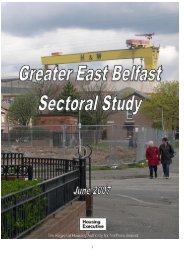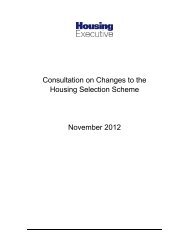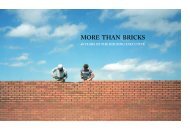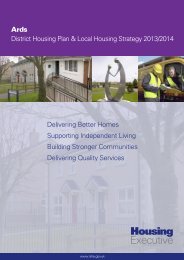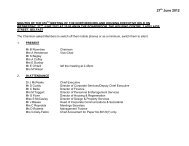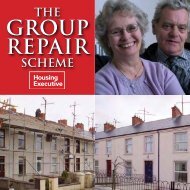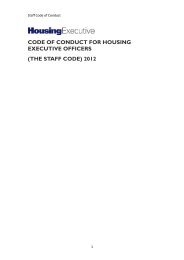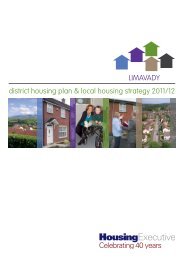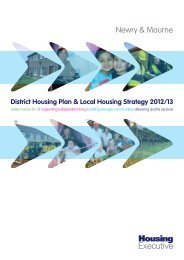House Price Index for Quarter 1 2013 - Northern Ireland Housing ...
House Price Index for Quarter 1 2013 - Northern Ireland Housing ...
House Price Index for Quarter 1 2013 - Northern Ireland Housing ...
You also want an ePaper? Increase the reach of your titles
YUMPU automatically turns print PDFs into web optimized ePapers that Google loves.
<strong>Quarter</strong>ly <strong>House</strong> <strong>Price</strong> <strong>Index</strong><br />
For Q1 <strong>2013</strong><br />
ISSN 1462 2351<br />
Report No. 114
<strong>Northern</strong> <strong>Ireland</strong> <strong>Quarter</strong>ly <strong>House</strong> <strong>Price</strong> <strong>Index</strong><br />
Introduction<br />
This survey analyses the per<strong>for</strong>mance of the <strong>Northern</strong><br />
<strong>Ireland</strong> housing market during the first quarter of <strong>2013</strong>,<br />
the months of January, February and March. The report<br />
is concerned with trends and spatial patterns in the<br />
housing market drawing comparisons with the first<br />
quarter of 2012, as a measure of annual change, and with<br />
the fourth quarter of 2012, as an indicator of quarterly<br />
change. The report is produced by the University of<br />
Ulster in partnership with the Bank of <strong>Ireland</strong> and the<br />
<strong>Northern</strong> <strong>Ireland</strong> <strong>Housing</strong> Executive.<br />
The price statistics are based on market evidence from a<br />
sample of 1,407 properties. The sample size represents a<br />
further small increase in the volume of sales compared<br />
to the final quarter of 2012 confirming the more active<br />
property market highlighted in the previous survey.<br />
In this report, in<strong>for</strong>mation is presented on the residential<br />
property market <strong>for</strong> <strong>Northern</strong> <strong>Ireland</strong>, with an analysis<br />
of sale price by different property types. The overall<br />
per<strong>for</strong>mance of the housing market is measured by a<br />
weighted index that reflects the market share of each<br />
property type. The index captures various movements<br />
within a single statistic and allows change over time to<br />
be tracked. Regional analysis considers trends in market<br />
areas throughout <strong>Northern</strong> <strong>Ireland</strong>.<br />
Contents<br />
Improving Sentiment<br />
<strong>Northern</strong> <strong>Ireland</strong>’s housing market:<br />
prospects <strong>for</strong> <strong>2013</strong> and beyond<br />
General Market Trends<br />
Per<strong>for</strong>mance by Property Type<br />
Per<strong>for</strong>mance by Region<br />
The <strong>House</strong> <strong>Price</strong> <strong>Index</strong><br />
Contributors<br />
Page 1<br />
Page 2<br />
Page 3<br />
Page 4<br />
Page 6<br />
Page 8<br />
Page 9
produced in partnership with 1<br />
May <strong>2013</strong><br />
Improving Sentiment<br />
The mini-revival in house sales in <strong>Northern</strong> <strong>Ireland</strong> continued<br />
during Q1 with the largest sample of reported transactions in the<br />
quarterly survey since Q4 2007. While acknowledging low base<br />
effects in the statistics, activity levels in the market during the first<br />
3 months of <strong>2013</strong> were up over 50% on the same period in 2012. The<br />
figures may appear a little more positive in the context of the few<br />
weeks of particularly adverse weather conditions that prevailed<br />
during March and the civil disturbances in January.<br />
The survey continues to highlight significant variances by<br />
geography – the Belfast market has been especially busy over<br />
the last quarter, accounting <strong>for</strong> almost one third of sales while<br />
conditions in some of the provincial locations and more rural<br />
locations remain tougher. As in previous surveys, the more<br />
densely populated commuter locations of North Down and<br />
Lisburn continue to post relatively strong per<strong>for</strong>mances on<br />
both the quarterly and annual comparisons.<br />
With an overall average price across the region of just over<br />
£131,000, the market has returned to levels last reported in<br />
the early months of 2005. After a period of relative stability<br />
in this measure, the changing mix and distribution of sales<br />
in the lower price bands has clearly had a significant impact<br />
on pushing the overall average price lower. In this latest survey,<br />
the terraced segment represents 30% of all sales (including<br />
a large concentration in Belfast) compared to 21% in Q1 2012<br />
while detached properties account <strong>for</strong> a smaller share.<br />
Supportive of these trends is a further re-profiling of price points<br />
with nearly half of all properties now sold at or below the £100,000<br />
level and around three quarters at or below £150,000.<br />
Both cash buyers and borrowers seeing value again<br />
Higher demand from both first time buyers at the new price<br />
points coupled with investors attracted by rental yields on some<br />
properties are reported as key drivers of increased activity while<br />
some modest loosening in the mortgage market, partly as a<br />
result of the UK Funding <strong>for</strong> Lending Scheme, may also be a<br />
positive influence.<br />
While cash-buying is clearly a feature of sales volumes at the<br />
lower end of the market, the latest regional mortgage data<br />
from CML is entirely consistent with this picture with a median<br />
advance <strong>for</strong> house purchase having declined to c £75,000 and<br />
below £70,000 <strong>for</strong> first-time buyers. Interestingly, though not<br />
widely recognised, the median advance as a percentage of prices,<br />
typically 75-80%, is now higher than that which prevailed pre the<br />
financial crisis, a commentary on the hyper-inflationary nature of<br />
the market in those days.<br />
While the average income of borrowers has fallen significantly from<br />
2007 peaks, in parallel the steep correction in prices and sustained<br />
period of exceptionally low interest rates has resulted<br />
in much improved af<strong>for</strong>dability measures with typical income<br />
multiples now below 3x and average capital and interest payments<br />
now less than 20% of income. For those who can gather up a deposit,<br />
it appears the decision to buy rather than rent has become more<br />
attractive <strong>for</strong> some at the new market levels.<br />
Prospects<br />
Seasonal trends should be supportive of higher sales volumes over<br />
the next few months while as we look ahead to the remainder of <strong>2013</strong><br />
and with the average price having now declined by around 50% from<br />
peak, the downside risks now seem limited. Short-term movements<br />
will of course continue to be strongly influenced by the precise mix<br />
of property sales during each quarter.<br />
We might expect typical “starter homes” and detached properties<br />
to at least maintain their value at around current levels but in<br />
contrast, the semi-detached segment may struggle a little without<br />
a more active “home-mover” market. Variable per<strong>for</strong>mance within<br />
the region will continue to be a characteristic of the market<br />
The macro economic backdrop is expected to remain difficult. We<br />
can take some encouragement from recent signals indicating a very<br />
marginal return to growth <strong>for</strong> the private sector – led by services –<br />
but the labour market recession continues with the jobless rate<br />
continuing to tick higher and worrying trends in both youth and<br />
long-term unemployment.<br />
Despite positive job announcements in some sectors and sterling<br />
per<strong>for</strong>mances from a number of our businesses, particularly in export<br />
markets, in reality the growth rate of the regional economy is unlikely<br />
to be robust enough to trigger a reversal in labour market trends <strong>for</strong><br />
some considerable time. Labour-intensive sectors such as construction<br />
and retailing continue to face into strong headwinds and will not be<br />
engines of job creation in the short-term. <strong>House</strong>hold finances remain<br />
tight and with inflation closer to 3%, many continue to face a drop in<br />
real living standards.<br />
As expected, at a UK level the March Budget featured a package of<br />
new and expanded housing measures under a Help to Buy banner.<br />
The policy intentions are clear – to lower the deposit hurdle <strong>for</strong> creditworthy<br />
households to get on the ladder or move home and make<br />
it easier <strong>for</strong> equity-constrained borrowers to remortgage – but the<br />
schemes are embryonic in nature and the potential application,<br />
if any, to the <strong>Northern</strong> <strong>Ireland</strong> market very uncertain.<br />
Alan Bridle<br />
UK Economist, Bank of <strong>Ireland</strong> UK<br />
T: 028 9043 3519 E: research@boini.com
2<br />
<strong>Northern</strong> <strong>Ireland</strong> <strong>Quarter</strong>ly <strong>House</strong> <strong>Price</strong> <strong>Index</strong><br />
<strong>Northern</strong> <strong>Ireland</strong>’s housing market:<br />
prospects <strong>for</strong> <strong>2013</strong> and beyond<br />
University of Ulster’s quarterly analysis of house prices in<br />
<strong>Northern</strong> <strong>Ireland</strong> <strong>for</strong> quarter 1, <strong>2013</strong> would indicate that the<br />
housing market is rather like the proverbial curate’s egg: good<br />
in parts. The further increase in the number of transactions<br />
and the increase of 1.9 per cent in the weighted average price<br />
of homes compared to quarter 1, 2012 are to be welcomed as<br />
further indications of a stabilising market. However, it is always<br />
important to put these developments in the context of wider<br />
economic and demographic fundamentals.<br />
The <strong>Housing</strong> Executive’s latest annual analysis of the housing<br />
market and its drivers (<strong>Northern</strong> <strong>Ireland</strong> <strong>Housing</strong> Market: Review<br />
& Perspectives <strong>2013</strong>-2016) does this by providing a synthesis of<br />
the most recent housing statistics and examining likely trends<br />
over the next three year period.<br />
The world economy is an important underlying determinant<br />
of developments in <strong>Northern</strong> <strong>Ireland</strong>’s housing market – above<br />
all because of the impact of developments in the world economy<br />
on the financial system and the propensity of banks / building<br />
societies to lend to potential homebuyers and investors. Analysis<br />
by the International Monetary Fund (IMF) in its World Economic<br />
Outlook Update (January <strong>2013</strong>) indicates that the world economy<br />
is expected to grow by 3.5 per cent in <strong>2013</strong>, a slightly higher rate<br />
than in 2012 (3.2%), if the euro area recovers. However,<br />
the expected upturn will be more gradual than in its<br />
October 2012 projections.<br />
In the USA, a “supportive financial market environment”, has been<br />
reflected in a significant increase in housing market activity and<br />
a reduction in the level of household debt. The biggest threat to<br />
world economic recovery comes from the sovereign debt crisis and<br />
the related economic crisis in the euro area. The IMF estimates<br />
that the euro area’s economy shrank by 0.4 per cent in 2012 and<br />
will continue to do so in <strong>2013</strong> (by -0.2%). The most recent banking<br />
crisis which emerged in Cyprus in March <strong>2013</strong> confirms that bank<br />
liquidity is still a major issue and would indicate that prolonged<br />
stagnation in the euro area is a very real possibility.<br />
The United Kingdom is experiencing the slowest post-recession<br />
recovery in its economy since the nineteenth century. Against<br />
this background and in the context of a continued Government<br />
commitment to austerity, in order to achieve further reductions in<br />
the budget deficit, the Chancellor announced what the Institute<br />
<strong>for</strong> Fiscal Studies characterised as a fiscally neutral budget on 21st<br />
March <strong>2013</strong>. The Office <strong>for</strong> Budgetary Responsibility (OBR) revised<br />
its <strong>for</strong>ecast <strong>for</strong> GDP growth in <strong>2013</strong> downwards from the 1.2 per<br />
cent (in December 2012’s Autumn Statement) to 0.6 per cent.<br />
<strong>Northern</strong> <strong>Ireland</strong>’s labour market remains uncertain<br />
(approximately one third of all people of working age are<br />
workless – the highest <strong>for</strong> any UK region) and real household<br />
incomes are falling – a position which may well be exacerbated<br />
by welfare re<strong>for</strong>m. Economic uncertainty is reflected in a more<br />
cautious approach by banks and building societies to prospective<br />
borrowers. Further public expenditure reductions may impact in<br />
a disproportionate way in <strong>Northern</strong> <strong>Ireland</strong>, where approximately<br />
one third of all employment is in the public sector and two thirds<br />
of GDP is dependent on it.<br />
The Review and Perspectives also notes that the underlying<br />
demographic driver of the housing market – the rate of household<br />
<strong>for</strong>mation - has slowed. Figures which emerged from the 2011<br />
Census showed that while population projections <strong>for</strong> 2011 had<br />
been very accurate, a slowing rate of household <strong>for</strong>mation<br />
– primarily as a result of the difficult economic environment –<br />
meant that there were approximately 12,000 fewer households<br />
than had been <strong>for</strong>ecast by the 2008-based household projections,<br />
something which is undoubtedly reflected in the demand<br />
<strong>for</strong> housing.<br />
Lack of effective demand has meant that private sector<br />
construction remains at a low level: around 4,500 new dwellings<br />
were constructed <strong>for</strong> the private sector in 2011/12 and early figures<br />
indicate a similar figure <strong>for</strong> 2012/13. The number is unlikely to<br />
increase much above this over the coming three year period.<br />
Co-Ownership has continued to play a valuable bridging role in<br />
enabling households on low incomes each year to become home<br />
owners. New funding commitments given by Government and<br />
lenders in November 2012 will enable Co-Ownership to secure<br />
an estimated 2,500 af<strong>for</strong>dable homes over a four year period.<br />
Almost one in five of all properties are now in the private rented<br />
sector, a tenure which is playing an increasingly important role<br />
in meeting the accommodation needs of younger households<br />
aspiring to become first-time buyers in the future and households<br />
on lower incomes, who in previous decades would have found<br />
suitable accommodation in the social sector. The continuation<br />
of direct payment of <strong>Housing</strong> Benefit to landlords in <strong>Northern</strong><br />
<strong>Ireland</strong> is seen as a major contributory factor to sustaining the<br />
viability of the sector in the longer term.<br />
The final document which will be launched on 16 May <strong>2013</strong><br />
indicates that prospects <strong>for</strong> <strong>Northern</strong> <strong>Ireland</strong>’s housing market<br />
over the next three years are there<strong>for</strong>e mixed. <strong>Price</strong>s may well<br />
drift down a little more – particularly in more peripheral areas<br />
where the labour market tends to be at its weakest. However,<br />
unless there is another major financial crisis or the world economy<br />
really fails to recover, it is very unlikely that there will be any<br />
further significant downturn in house prices in <strong>Northern</strong> <strong>Ireland</strong>.<br />
Joe Frey<br />
Head of Research, NIHE<br />
T: 02890 318540<br />
E: joe.frey@nihe.gov.uk
produced in partnership with 3<br />
General Market Trends<br />
The key finding of this report is confirmation of a more active housing market in<br />
<strong>Northern</strong> <strong>Ireland</strong>. The overall average price remains highly af<strong>for</strong>dable, there has<br />
been a weighted increase of 1.9% over the year and the volume of transactions<br />
is significantly higher relative to the start of 2012.<br />
This report provides evidence of a housing market that is starting<br />
to emerge from a long period of weak per<strong>for</strong>mance. The statistics<br />
represented in this report give tentative support to the view that<br />
the housing market may now be entering into a period of recovery<br />
though per<strong>for</strong>mance remains highly variable and the market<br />
is vulnerable to shocks of a differing nature. For example the<br />
prolonged winter period appears to have impacted negatively and<br />
extended the seasonal effects that tend to occur in the first quarter.<br />
The overall average price of residential property in <strong>Northern</strong> <strong>Ireland</strong><br />
<strong>for</strong> the first quarter of <strong>2013</strong> is £131,128, a figure which on first sight<br />
is seemingly lower than <strong>for</strong> recent quarters. However a large part<br />
of this variation is a result of a change in sample mix arising from<br />
differences in the volume of sales by property type. The weighted<br />
index, which has been the preferred measure <strong>for</strong> these surveys and<br />
takes into consideration the respective change <strong>for</strong> each property<br />
type and their weighting, indicates that when the sample mix is<br />
allowed <strong>for</strong> there has been a 1.9% increase in house prices at the<br />
aggregate level over the year.<br />
The distribution of prices highlights the af<strong>for</strong>dable price structure<br />
<strong>for</strong> housing in <strong>Northern</strong> <strong>Ireland</strong> with a significant increase in the<br />
percentage of properties within the lower price bands. For this<br />
survey 45% of properties sold at or below £100,000 suggesting that<br />
considerable value exists in the market though as later commentary<br />
shows there is a significant difference between market areas. The<br />
increased number of properties in the lower price bands is further<br />
evidenced by the fact that nearly three quarters (73%) of the sample<br />
sold at or below £150,000 and 86% at or below £200,000. Overall<br />
93% of properties sold were exchanged at or below £250,000 and<br />
95% at or below £300,000. The price profile highlights comments<br />
from the agency sector regarding the availability of af<strong>for</strong>dable stock<br />
and a growing confidence and appetite of investors and first-time<br />
buyers to enter the market, arising from the emergence of finance<br />
products, the perception of high yields in the investment market<br />
and a potential period of relative stability.<br />
The market share by property type rein<strong>for</strong>ces the previous<br />
point concerning a high volume of lower priced properties<br />
reflected by the increased representation of the terrace/<br />
townhouse sector (30%, n=417). Semi-detached houses likewise<br />
have an increased representation in the sample (28%, n=388).<br />
Correspondingly the sample size is lower in both relative and<br />
absolute terms <strong>for</strong> detached houses (21%, n=303) and detached<br />
bungalows (8%, n=106). Semi-detached bungalows with 3% of the<br />
sample (n=47) remain the smallest property type and as such exert<br />
little influence on the weighted property index. Apartments have<br />
maintained a reasonably significant though slightly lower share<br />
of the market (10%, n=146). The number of transactions in the<br />
new build sector (n=265) is up on the previous survey with<br />
a 19% share of the market.<br />
Market share by type of property<br />
Terrace 30%<br />
Semi-detached house 28%<br />
Detached house 21%<br />
Semi-detached bungalow 3%<br />
Detached bungalow 8%<br />
Apartment 10%
4<br />
<strong>Northern</strong> <strong>Ireland</strong> <strong>Quarter</strong>ly <strong>House</strong> <strong>Price</strong> <strong>Index</strong><br />
Per<strong>for</strong>mance by Property Type<br />
As reported in recent surveys per<strong>for</strong>mance by property type remains variable with<br />
mixed messages concerning price trends.<br />
Annual per<strong>for</strong>mance provides a snapshot comparing the current<br />
average price with corresponding statistics <strong>for</strong> the first quarter<br />
of 2012. Given the relatively weaker market conditions in terms<br />
of transaction evidence at the start of 2012, the comparative<br />
per<strong>for</strong>mance still captures these influences leading to relatively<br />
wide variations in price change across the main property types.<br />
This is apparent with four property types increasing in average<br />
price over the year but with the other two still experiencing lower<br />
average prices. The strongest annual per<strong>for</strong>mance has been <strong>for</strong><br />
detached houses (£215,261) with the overall average price relative<br />
to the first quarter of 2012 up by 6.4%. Detached bungalows<br />
(£145,786) also increased but at a lower rate of 3.1%. The terraced/<br />
townhouse sector has per<strong>for</strong>med strongly (£85,351) over the<br />
year up by 5.5% indicating that price growth has been across the<br />
market and not confined to the detached sector. The apartment<br />
sector (£102,959) has also per<strong>for</strong>med better over the year up by<br />
2.8%. However, on the downside, the average price (£103,180) of<br />
semi-detached bungalows is lower by 11.5%, but as noted earlier<br />
this sector of the market is small and makes little impact on the<br />
overall weighted per<strong>for</strong>mance. However, of more significance is<br />
the reduced average price of semi-detached houses (£124,605)<br />
down by 5.3% over the year.<br />
Short-term per<strong>for</strong>mance considers average price levels against<br />
those experienced in the fourth quarter of 2012.The quarterly<br />
perspective shows a reduction in prices across the board apart<br />
from terraced/townhouses <strong>for</strong> which the average price increased<br />
by 0.4%. For some property types the percentage decline is<br />
relatively small; in the case of apartments 0.6%, semi-detached<br />
bungalows 1.4% and semi-detached houses by 2.0%. Reflecting these<br />
collective changes, the overall picture is a weighted decline of 2.7% over<br />
the quarter. Reasons <strong>for</strong> the lower prices in the first quarter may reflect<br />
seasonality in the housing market and, in particular, the extended<br />
winter conditions throughout the month of March. As to whether the<br />
more uncertain political climate and street protests has impacted on<br />
prospective purchasers viewing property is difficult to assess though<br />
some contributing agents have considered the situation as not being<br />
helpful to the market.<br />
Annual % change and average price<br />
Market sector Annual Average <strong>Price</strong><br />
Change <strong>Quarter</strong> 1 <strong>2013</strong><br />
Terraced/townhouse 5.5% £85,351<br />
Semi-detached house -5.3% £124,605<br />
Detached house 6.4% £215,261<br />
Semi-detached bungalow -11.5% £103,180<br />
Detached bungalow 3.1% £145,786<br />
Apartment 2.8% £102,959
produced in partnership with 5<br />
Average price by region and property type<br />
Region All Terrace SD <strong>House</strong> Detached <strong>House</strong><br />
<strong>Northern</strong> <strong>Ireland</strong> £131,128 £85,351 £124,605 £215,261<br />
Belfast £135,385 £85,655 £150,971 £238,361<br />
North Down £183,292 £105,240 £161,333 £313,382<br />
Lisburn £167,107 £132,528 £137,127 £241,808<br />
East Antrim £107,172 £69,572 £104,456 £186,618<br />
L’derry/Strabane £89,770 £60,462 £83,893 £168,744<br />
Antrim/Ballymena £97,171 £52,697 £97,291 £136,000<br />
Coleraine/Limavady/North Coast £119,934 £117,822 £102,072 £150,304<br />
Enniskillen/Fermanagh/South Tyrone £86,197 £55,600 * £109,409<br />
Mid Ulster £105,225 £75,539 £84,458 £132,062<br />
Mid and South Down £136,258 £86,497 £99,048 £220,075<br />
Craigavon/Armagh £100,482 £49,493 £82,031 £259,264<br />
Region SD Bungalow Detached Bungalow Apartment<br />
<strong>Northern</strong> <strong>Ireland</strong> £103,180 £145,786 £102,959<br />
Belfast * £207,545 £112,555<br />
North Down £123,050 £160,563 £116,241<br />
Lisburn * £192,500 £86,977<br />
East Antrim £107,188 £137,625 £67,400<br />
L’derry/Strabane * £111,400 *<br />
Antrim/Ballymena £95,400 £130,656 *<br />
Coleraine/Limavady/North Coast £94,643 £129,600 £111,945<br />
Enniskillen/Fermanagh/South Tyrone * £96,929 *<br />
Mid Ulster * £123,556 *<br />
Mid and South Down * £167,850 £69,571<br />
Craigavon/Armagh * £133,869 *
6<br />
<strong>Northern</strong> <strong>Ireland</strong> <strong>Quarter</strong>ly <strong>House</strong> <strong>Price</strong> <strong>Index</strong><br />
Per<strong>for</strong>mance by Region<br />
At the regional level, trends are again highly variable with some markets showing<br />
signs of uplift but other areas experiencing a significant downward movement in<br />
prices. For certain regions, prices and variability of price trends tend to be a function<br />
of a constrained evidence base and thin markets in terms of transaction evidence.<br />
Belfast<br />
Recent reports have highlighted an improving market in Belfast,<br />
however, the message from this survey is more mixed. In terms<br />
of transaction evidence, it is apparent that the volume of sales is<br />
up (440 <strong>for</strong> this survey) but the overall average price (£135,385) is<br />
lower. The latter partly reflects the high concentration of terrace/<br />
townhouses and apartments in this survey <strong>for</strong> Belfast (collectively<br />
52%) and the relatively low volume of detached property (18%). In<br />
terms of individual sectors of the market, semi-detached houses<br />
(£150,971) are up by 6.1% over the year and in this respect they are<br />
the market leader in this survey. The average price of detached<br />
houses (£238,361) is somewhat lower down by 2.5% over the year<br />
and apartments (£112,555) are down by 1.5%. The terrace/townhouse<br />
sector (£85,655) shows the largest reduction in average price<br />
down by 5.7% over the year. Over the quarter a similar pattern<br />
prevails with average price levels lower though apartments<br />
remain unchanged.<br />
The variability in price levels is again apparent across the<br />
geographical sectors of the Belfast market. South Belfast (£166,508)<br />
is again the highest priced sub-market in Belfast, with the average<br />
price of terraced/townhouses £120,808, semi-detached houses<br />
£187,071, detached houses £284,318 and apartments £123,426. The<br />
average price in East Belfast is £134,172, with terraced/townhouses<br />
£82,275, semi-detached houses £147,095, detached houses £226,366<br />
and apartments £104,393. The average price <strong>for</strong> West Belfast is<br />
£105,603, with terraced/townhouses £77,571, semi-detached houses<br />
£122,289, detached houses £183,894 and apartments £83,044.<br />
North Belfast (£76,144) is again the lowest priced, with terraced/<br />
townhouses £43,970 and semi-detached houses £94,663.<br />
Belfast Metropolitan Area<br />
Within the commuter zone of the Belfast Metropolitan Area,<br />
the three local markets continue to display contrasting positions<br />
with North Down and Lisburn displaying strong growth in average<br />
price levels but East Antrim per<strong>for</strong>ming less well.<br />
For North Down, the overall average price (£183,292) is up over<br />
the year by 16.1% and has also strengthened over the last quarter<br />
(up by 9.4%). However, variability between property sectors is still<br />
a characteristic of the local market. Over the annual time-scale,<br />
detached houses (£313,382) have per<strong>for</strong>med very strongly and<br />
contribute significantly to the overall picture <strong>for</strong> this market. At the<br />
other end of the market, the terrace/townhouse sector (£105,240)<br />
has also shown a strong recovery this quarter. Likewise, apartments<br />
(£116, 241) have increased over the year though the average price of<br />
this sector has declined over the quarter. In contrast, semi-detached<br />
houses (£161,333) while showing a significantly stronger price<br />
structure over the quarter are slightly below their average<br />
price at the start of 2012.<br />
For Lisburn, the overall average price of £167,107 is very much<br />
in alignment with that <strong>for</strong> the final quarter of 2012, up by 3.3%<br />
confirming the improving position of the local market. A strong<br />
per<strong>for</strong>mance is apparent <strong>for</strong> detached houses (£241,808) and<br />
detached bungalows (£192,500) which again lead the market over<br />
both the annual and quarterly time-scales though at the other<br />
end of the market, the terrace/townhouse sector (£132,528) also<br />
continues to strengthen. In contrast, the average price of semidetached<br />
houses (£137,127) remains static over the year<br />
but significantly improved over the quarter.<br />
In East Antrim, there is a contrasting picture with the overall<br />
average price (£107,172) lower over both the annual and quarterly<br />
time-scale. The findings from this survey suggests that over<br />
this quarter the East Antrim market has per<strong>for</strong>med at a much<br />
lower level relative to the other commuter markets within the<br />
Belfast Metropolitan Area. However the picture varies across the<br />
property types. Terrace/townhouses (£69,572) are exhibiting a<br />
high degree of fluctuation, with the average price up over the year<br />
but appreciably lower <strong>for</strong> the quarter. Both semi-detached houses<br />
(£104,456) and detached houses (£186,618) are characterised by<br />
lower average prices, as indeed are detached bungalows (£137,625)<br />
and apartments (£67,400).<br />
The North and North West<br />
The overall picture in the North and North West is one of weaker<br />
markets during the first quarter of <strong>2013</strong> though per<strong>for</strong>mance<br />
remains variable.<br />
For Antrim/Ballymena the overall average price (£97,171) is<br />
significantly lower this quarter having shown distinct signs of<br />
improving towards the end of 2012. The pattern of lower price<br />
levels is apparent across all property types. For example, detached<br />
houses (£136,000) have a significantly lower average price, a<br />
pattern reflected in the semi-detached house market (£97,291),<br />
detached bungalows (£130,656) and in the terraced/townhouse<br />
sector (£52,697). The relatively weaker per<strong>for</strong>mance <strong>for</strong> Antrim/<br />
Ballymena may be a reflection of the seasonal factors discussed at<br />
the <strong>Northern</strong> <strong>Ireland</strong> level and a combination of more local market<br />
influences.<br />
For the Coleraine/Limavady/North Coast market, the overall<br />
average price (£119,934) is down slightly relative to the final quarter<br />
of 2012 by 0.9%, but 6.8% lower than first quarter of 2012. On an<br />
annual basis, it is apparent that considerable variability still exists<br />
in the market with both the terrace/townhouse (£117,822) sector<br />
and apartments (£111,945) showing a considerable uplift in average<br />
price. However, on the downside, semi-detached houses (£102,072),<br />
detached houses (£150,304) and detached bungalows (£129,600)<br />
have lower average price levels relative to the first quarter of 2012.
produced in partnership with 7<br />
In the Derry/Strabane market, a picture similar to that <strong>for</strong> the final<br />
quarter of 2012 prevails. The overall average price (£89,770) is down<br />
relative to the first quarter of 2012 but has improved slightly over the<br />
quarter. The pattern of price movements remains highly diverse with<br />
terraced/townhouses (£60,462) and semi-detached houses (£83,893)<br />
down but with some evidence of price growth <strong>for</strong> detached houses<br />
(£168,744). Again a small volume of transactions makes it difficult to be<br />
definitive about this market area though the 3.2% increase in overall<br />
average price <strong>for</strong> the quarter may point to more favourable market<br />
conditions in the second quarter.<br />
The West<br />
10<br />
8 9<br />
12<br />
6<br />
7<br />
5<br />
1<br />
4 3<br />
2<br />
The two markets in the West of <strong>Northern</strong> <strong>Ireland</strong> are still characterised<br />
by fluctuating and relatively low house prices.<br />
The Mid-Ulster market with an overall average price of £105,225<br />
represents a slight improvement up by 2.8% relative to the final quarter<br />
of 2012 (£102,400) but when compared to the first quarter of 2012 the<br />
average price is significantly below that pertaining a year ago. This<br />
picture is reflected in lower average prices across the main property types<br />
though there are differences between annual and quarterly per<strong>for</strong>mance.<br />
For example, terraced/townhouses (£75,539) show a significant decline<br />
over the year but the average price is considerably improved relative to<br />
the previous quarter. Such inconsistency is reflective of the volume of<br />
transactions that has prevailed and also characterises other property<br />
types such as detached houses (£132,062), semi-detached houses<br />
(£84,458) and detached bungalows (£123,556).<br />
The Enniskillen/ Fermanagh/ South Tyrone market shows similar<br />
characteristics to that <strong>for</strong> Mid-Ulster. The overall average house price<br />
(£86,197) is significantly lower indicating a weak per<strong>for</strong>mance over<br />
the quarter. This is translated into house prices which, in the main, are<br />
downward although the terraced/townhouse market (£55,600) (starting<br />
from a low base) is up by 3.7% over the year and detached bungalows<br />
(£96,929) have also increased in average price.<br />
The South<br />
The picture <strong>for</strong> the South of <strong>Northern</strong> <strong>Ireland</strong> reflects uncertainties<br />
in the market during the first quarter of <strong>2013</strong>.<br />
For Craigavon/Armagh, the overall average price (£100,482) is slightly<br />
lower over the year by 1.5% but 9.8% below that <strong>for</strong> the final quarter<br />
of 2012. As noted in previous surveys, small sample sizes may result in<br />
unrepresentative swings. For this survey the strong per<strong>for</strong>mance of<br />
detached houses (£259,264) contrasts with the wider picture <strong>for</strong> the<br />
market area and that <strong>for</strong> other property types. For example, the average<br />
prices <strong>for</strong> terraced/townhouses (£49,493) and semi-detached houses<br />
(£82,031) are considerably reduced.<br />
Location<br />
11<br />
14<br />
13<br />
Average <strong>Price</strong><br />
<strong>Quarter</strong> 1<br />
<strong>Northern</strong> <strong>Ireland</strong> - All £131,128<br />
Belfast - All £135,385<br />
1. North Belfast £76,144<br />
2. South Belfast £166,508<br />
3. East Belfast £134,172<br />
4. West Belfast £105,603<br />
5. North Down £183,292<br />
6. Lisburn £167,107<br />
7. East Antrim £107,172<br />
8. L’derry/Strabane £89,770<br />
9. Antrim/Ballymena £97,171<br />
10. Coleraine/Limavady/N. Coast £119,934<br />
11. Enniskillen/Fermanagh/S.Tyrone £86,197<br />
12. Mid Ulster £105,225<br />
13. Mid & South Down £136,258<br />
14. Craigavon/Armagh £100,482<br />
For Mid & South Down, the overall average sale price (£136,258) is<br />
consistent with the trend <strong>for</strong> the latter half of 2012: fourth quarter<br />
(£133,106) and third quarter (£134,191). These statistics would suggest<br />
that the property market in this area is consolidating and starting to<br />
move <strong>for</strong>ward. However, relative to the first quarter of 2012, the overall<br />
average price level is down by 10.4%, a picture which is apparent across<br />
most property types. For example, the terraced/townhouse sector<br />
(£86,497) is down over the year but up strongly relative to the final<br />
quarter of 2012, semi-detached houses (£99,048) are largely unchanged<br />
over the quarter but down on an annual basis. Detached houses<br />
(£220,075) exhibit a similar picture down in price over the year<br />
but unchanged relative to the final quarter of 2012.
8<br />
<strong>Northern</strong> <strong>Ireland</strong> <strong>Quarter</strong>ly <strong>House</strong> <strong>Price</strong> <strong>Index</strong><br />
The <strong>House</strong> <strong>Price</strong> <strong>Index</strong><br />
The long-term house price index is<br />
calculated relative to price levels <strong>for</strong><br />
each property type at the base quarter<br />
<strong>for</strong> the survey, the final quarter<br />
of 1984. The overall index at<br />
487.09 is lower <strong>for</strong> this survey.<br />
The pattern of the house price index since 2009 is<br />
one of uneven per<strong>for</strong>mance supporting opinion that<br />
recovery in the <strong>Northern</strong> <strong>Ireland</strong> housing market<br />
is likely to be highly variable. The current survey<br />
underlines this contention with rising prices over<br />
the year but lower prices over the quarter.<br />
index value<br />
1000<br />
800<br />
600<br />
400<br />
200<br />
0<br />
1985<br />
1986<br />
1987<br />
1988<br />
1989<br />
1990<br />
1991<br />
1992<br />
1993<br />
1994<br />
1995<br />
1996<br />
1997<br />
1998<br />
1999<br />
2000<br />
2001<br />
2002<br />
2003<br />
2004<br />
2005<br />
2006<br />
2007<br />
2008<br />
2009<br />
2010<br />
2011<br />
2012<br />
year<br />
<strong>2013</strong><br />
Retail <strong>Price</strong> <strong>Index</strong><br />
NI <strong>House</strong> <strong>Price</strong> <strong>Index</strong>
produced in partnership with 9<br />
Contributors<br />
• Acorn Homes<br />
• Alexander, Reid & Frazer<br />
• Armoy Homes Property Services<br />
• Armstrong Gordon Estate Agents<br />
• Bennett and Lisk Residential Estate Agents<br />
• Best Property Services<br />
• Bill McCann Estate Agency<br />
• Bill McKelvey Estate Agents<br />
• Blair & Boyd<br />
• Brian A. Todd & Co.<br />
• Brian O’Hare Estate Agents<br />
• Brian Wilson Estate Agents<br />
• Brice & Co. Estate Agents<br />
• BTWShiells Residential<br />
• Burns & Co.<br />
• Cookstown Property Services<br />
• Corry & Stewart Ltd<br />
• Country Estates<br />
• Cowley Property<br />
• CPS Property<br />
• Curran Associates<br />
• Dallas Real Estate<br />
• Daniel Henry Estate Agents<br />
• Daniel McGeown Estate Agents<br />
• DMC Properties & Mortgages<br />
• Donnybrook Estate Agents<br />
• Eadie McFarland & Co.<br />
• Eddie O’Connor Estate Agents<br />
• Falloon Estate Agents<br />
• Frank A McCaughan & Son<br />
• Fred Dalzell & Partners<br />
• Gerry O’Connor Estate Agent<br />
• HA McIlwrath & Sons Ltd<br />
• Hampton Estates<br />
• Hanna Hillen Estates<br />
• Harry Clarke & Co.<br />
• Harte & McGarrigle Ltd<br />
• Homes Independent<br />
• HR Douglas & Sons<br />
• Hunter Campbell<br />
• J. A. McClelland & Sons<br />
• James Wilson & Son<br />
• JG Fleming<br />
• John Grant Limited<br />
• John McQuoid & Sons<br />
• John Minnis Estate Agents & Property Consultants<br />
• John V Arthur Estate Agents<br />
• Jones Estate Agents<br />
• Joyce Clarke Estate Agents<br />
• Kieran Taggart Estate Agency<br />
• Lindsay Fyfe & Co.<br />
• Lindsay Shanks Estate Agents<br />
• Locate Estate Agents<br />
• Mannelly & Co. Ltd<br />
• Mark McAlpine & Co.<br />
• Martin & Dunlop<br />
• McAfee Properties & Mortgages<br />
• McClelland Salter<br />
• McDonagh Property Consultants & Chartered Surveyors<br />
• MacFarlane & Smyth<br />
• McGlone McCabe<br />
• McMillan Estate Agents<br />
• Michael Chandler Estate Agents<br />
• Michael Hannath Property Consultancy & Estates Agents<br />
• Mid Ulster Properties<br />
• Montgomery Finlay & Co.<br />
• Morris Estate Agents<br />
• Mortgage Property Estate Agents<br />
• Morton Pinpoint<br />
• Neill Estate Agents<br />
• Norman Devlin Property Consultants & Surveyors<br />
• Norman Morrow & Co.<br />
• Oakland Estate Agents<br />
• O’Reilly Property Services<br />
• Paul O’Keefe Estate Agents<br />
• Peter Rogers Estate Agents<br />
• Philip Tweedie And Company<br />
• Pinkerton Murray<br />
• PJ Bradley Property Services<br />
• PJ McIlroy & Son<br />
• Pollock Estate Agents<br />
• Pooler Estate Agency<br />
• Premier Properties<br />
• Quinn & Company<br />
• RA Noble & Co. Auctioneers & Estate Agents<br />
• Rainey & Gregg Property & Mortgage Centre<br />
• R Benson & Son<br />
• Reeds Rains<br />
• Relocate<br />
• Robert Ferris Estate Agents & Valuers<br />
• Robert Wilson Estate Agency Group<br />
• Robert Quigley Estate Agents<br />
• Sawyer & Co.<br />
• Shanks & Company Estate Agents<br />
• Seamus Cox & Co.<br />
• Shooter Property Services<br />
• Smyth Properties Countrywide<br />
• Stanley Best Estate Agents<br />
• Stephen Carson<br />
• Stevenson & Cumming<br />
• Taylor & Co.<br />
• Templeton Robinson<br />
• Terry Millar<br />
• The Property Spot<br />
• Tim Martin & Co.<br />
• Ulster Property Sales<br />
• Vision Property Agents<br />
• William Porter & Son<br />
• Wylie Estate Agents
We have credit<br />
available and<br />
we want to lend<br />
At Bank of <strong>Ireland</strong> UK we’re here to help<br />
you with advice and in<strong>for</strong>mation on the<br />
finance options available to you.<br />
We recently launched our Mortgage Fund<br />
and our Agri Business Investment Fund<br />
and substantial amounts are available to<br />
lend within these during <strong>2013</strong>. The funds<br />
are open if you are a new or existing<br />
customer to support you to get where<br />
you want to go.<br />
To find out more about these funds or what<br />
other options we can provide contact us today.<br />
Drop into your local branch<br />
0800 0850 444<br />
www.bankofireland.co.uk<br />
YOUR HOME MAY BE REPOSSESSED IF YOU DO NOT KEEP UP REPAYMENTS ON<br />
YOUR MORTGAGE.<br />
All lending facilities are subject to the Bank’s lending conditions. Terms and conditions apply.<br />
Lending facilities other than regulated mortgages are not regulated by the Financial Services Authority. Bank of <strong>Ireland</strong> UK subscribes<br />
to the Lending Code. Bank of <strong>Ireland</strong> UK is a trading name of Bank of <strong>Ireland</strong> (UK) plc which is authorised and regulated by the<br />
Financial Services Authority. Registered in England and Wales (No. 7022885), Bow Bells <strong>House</strong>, 1 Bread Street, London EC4M<br />
9BE.<br />
6997130206



